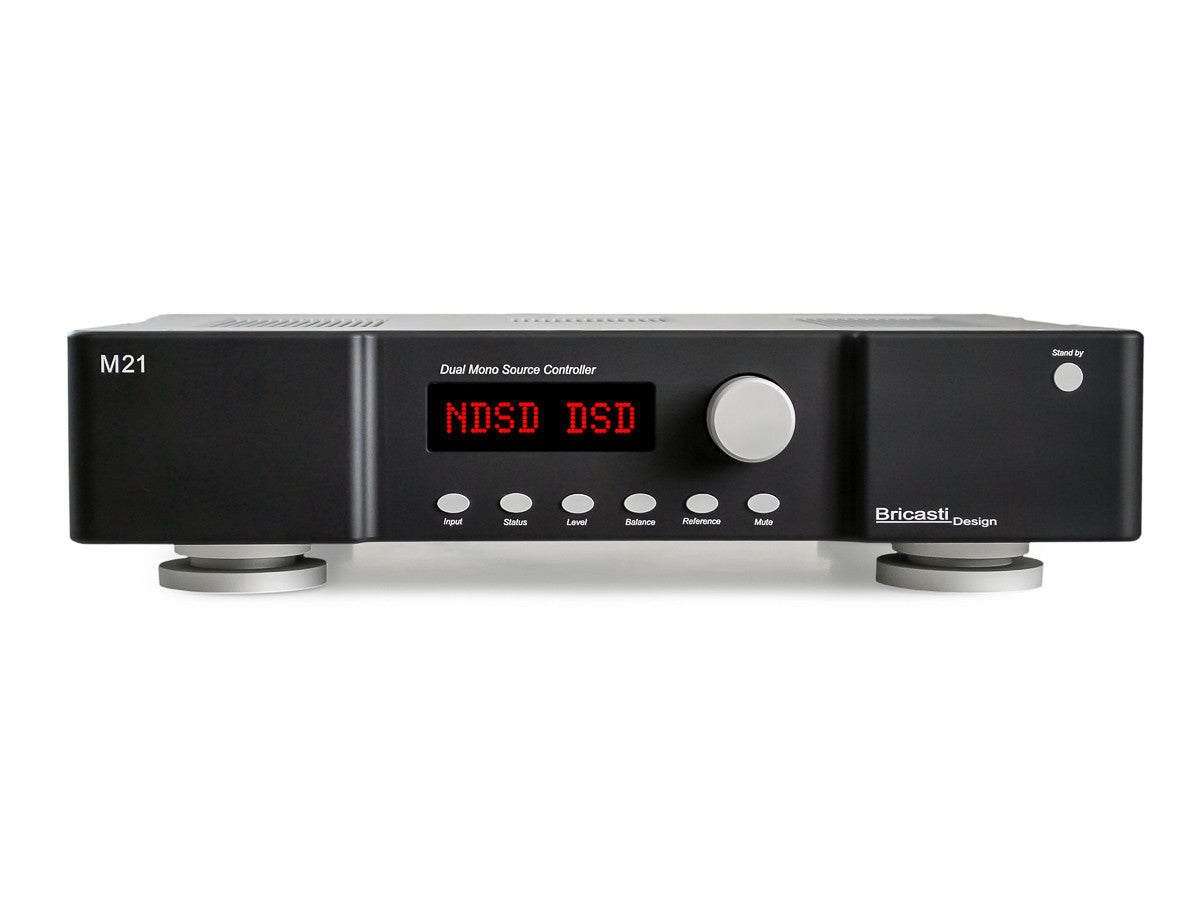
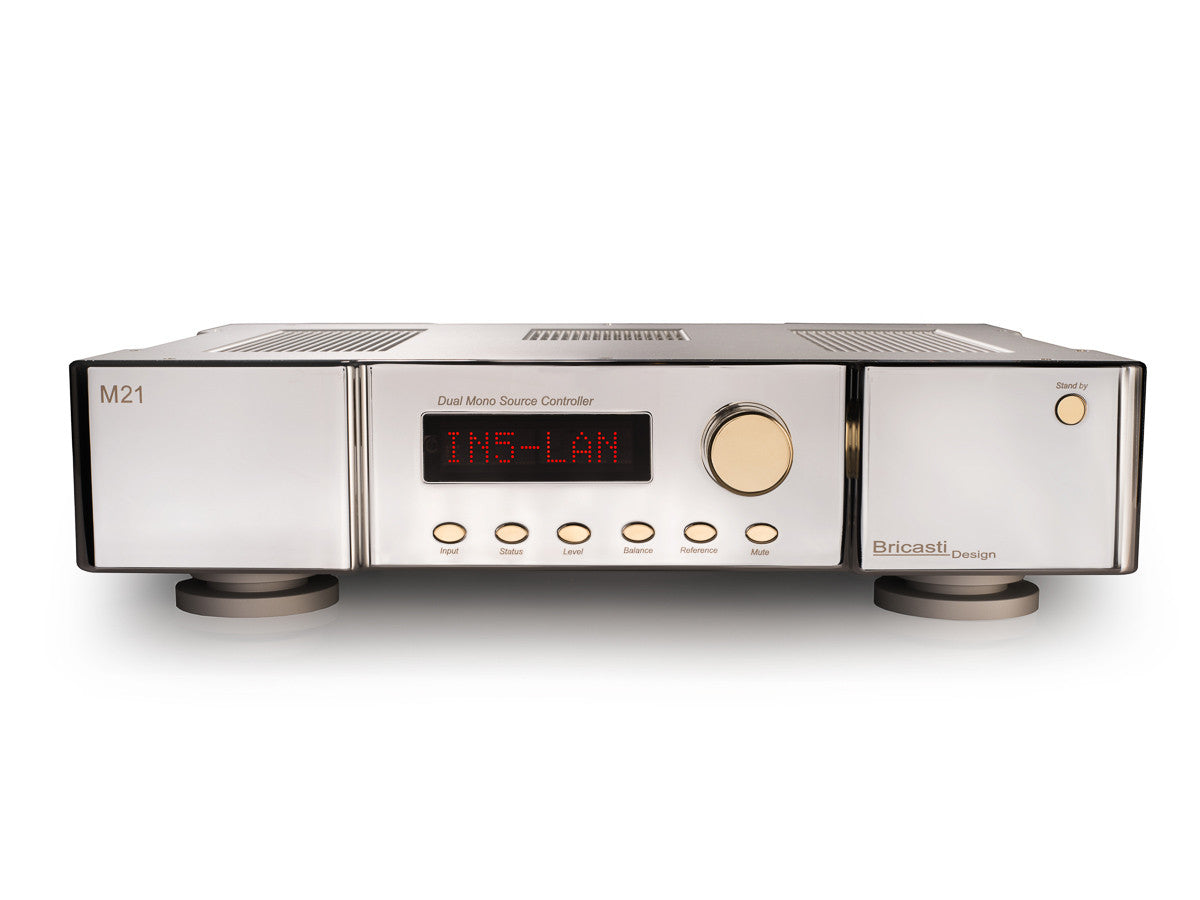
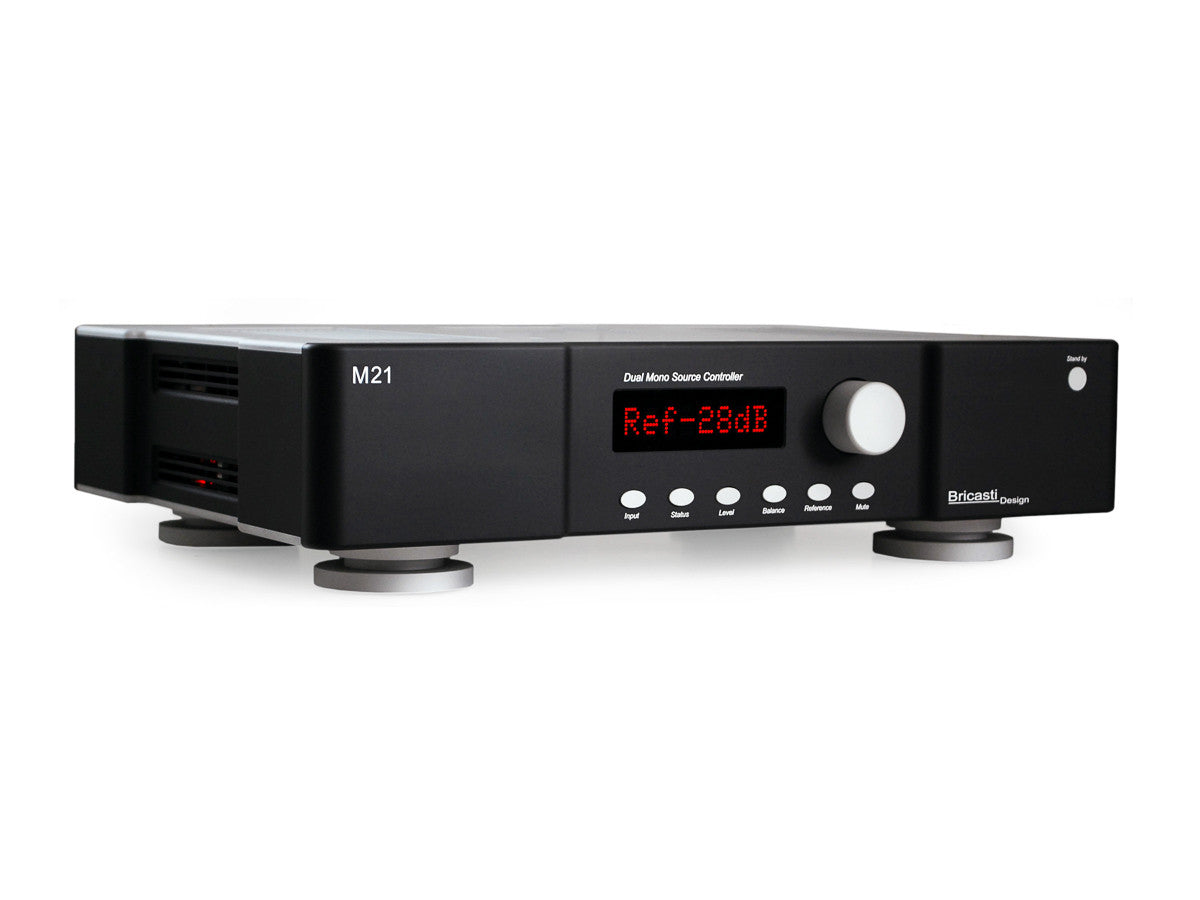
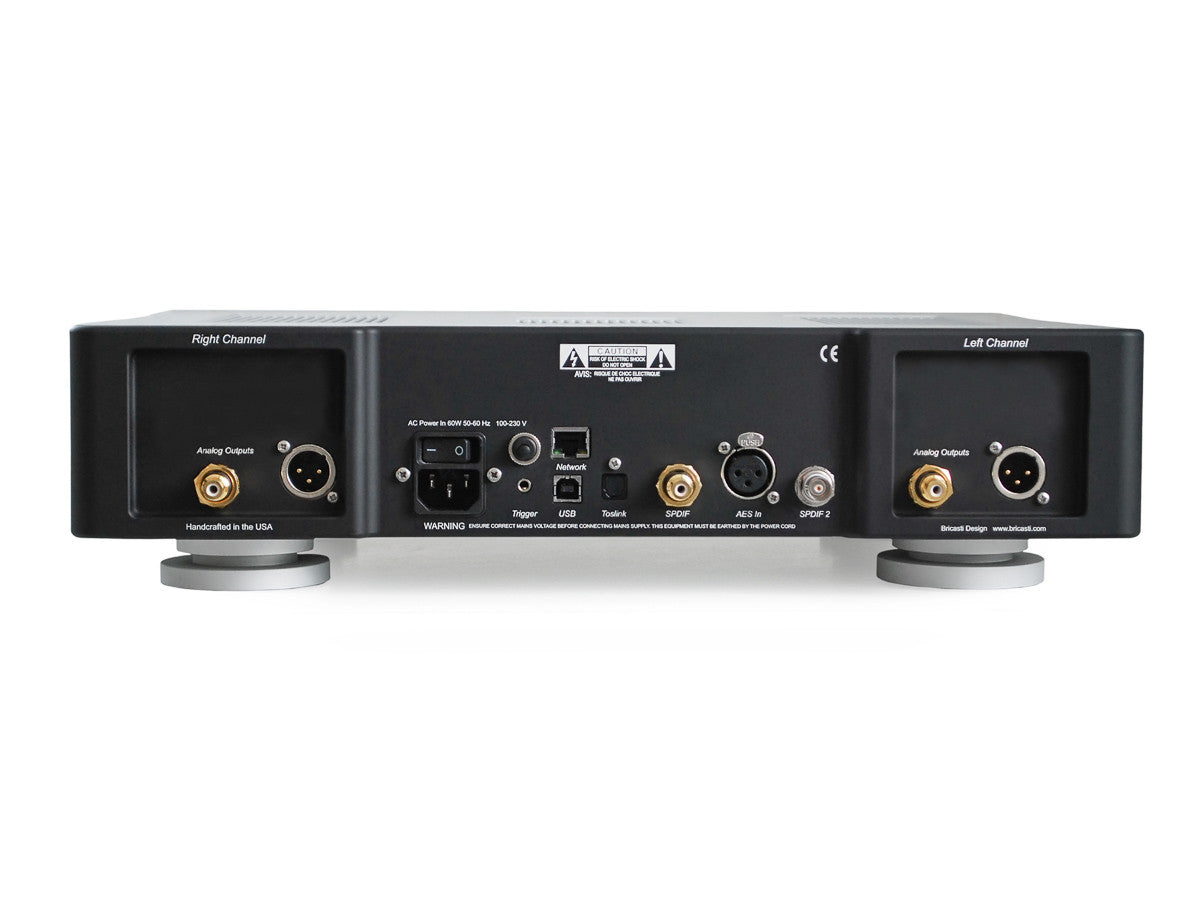
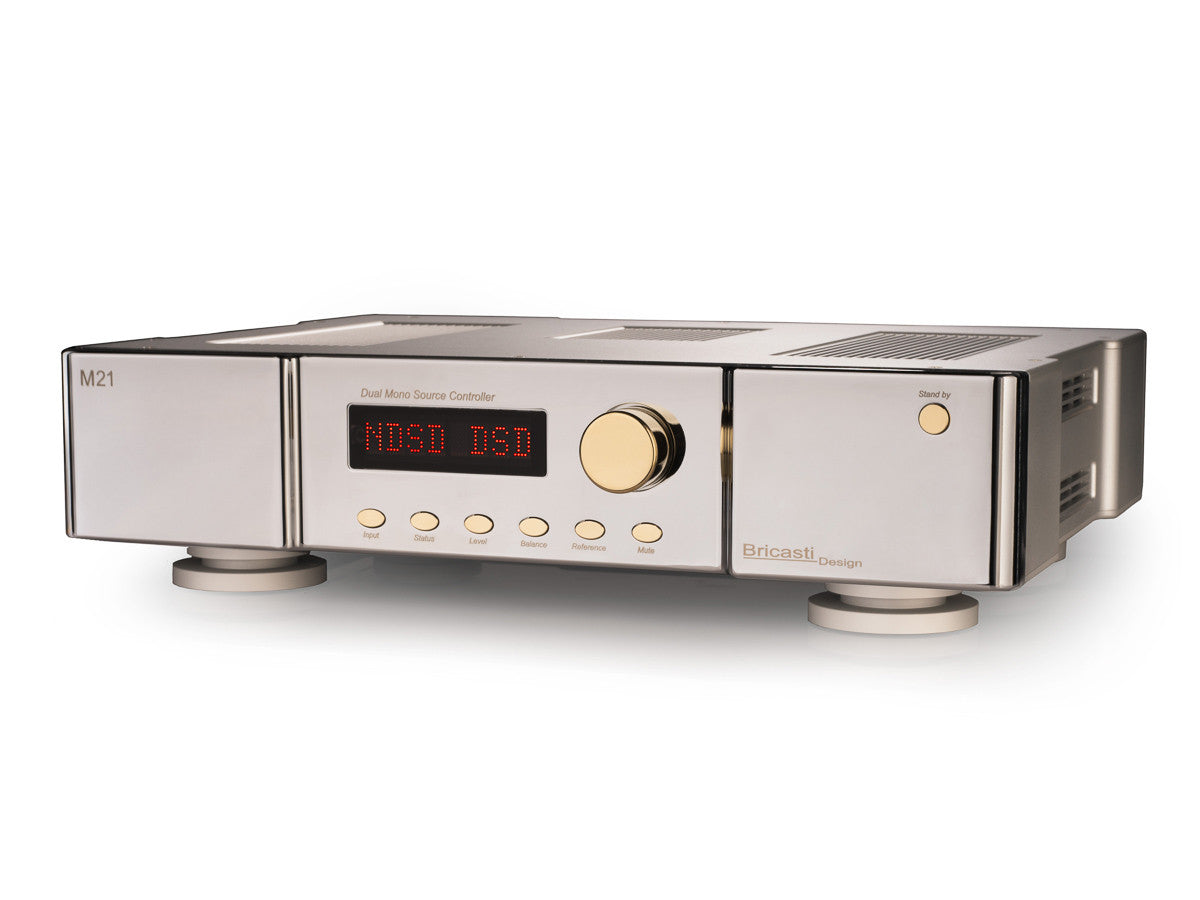
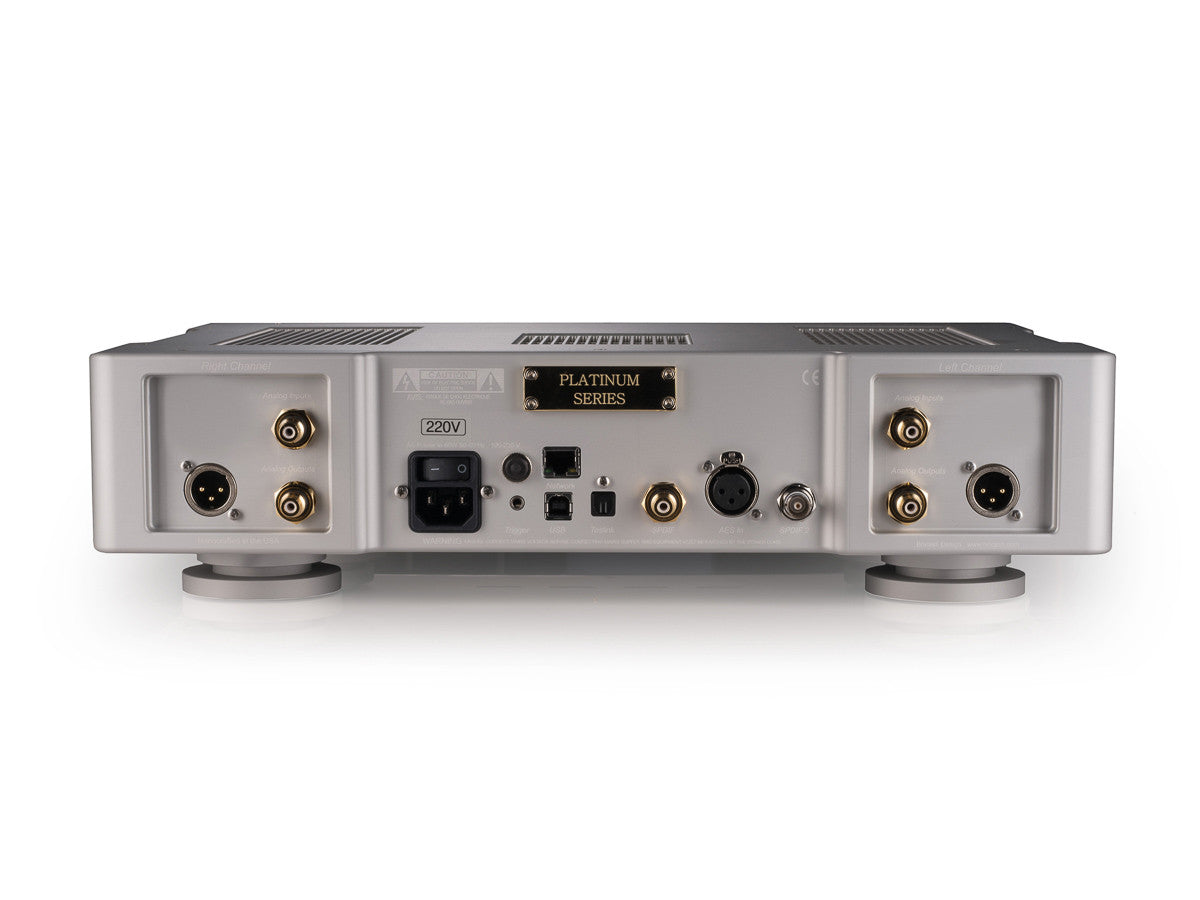
The pinnacle of digital-to-analog conversion: the M21 Platinum Series. Offering a triumvirate of meticulously crafted signal paths, users can select from three distinct options for converting digital signals to analog. Choose between the delta-sigma and ladder DAC paths for precise PCM conversion, or opt for the true direct DSD path for an unparalleled DSD playback experience. Supporting a wide array of digital input types, the M21 ensures compatibility with all your devices. Additionally, it provides the flexibility of direct output or seamless hard-wire bypass of the analog attenuator, allowing you to tailor your audio setup to your preferences.
The M21 Digital-to-Analog Converter represents the culmination of years of innovation and refinement, building upon the legacy of both the M1 Special Edition and the M12 Dual Mono Source Controller. With each iteration, Bricasti Design continues to push the boundaries of audio excellence, delivering a converter that embodies the epitome of precision, fidelity, and versatility. Pairs well with the M19 SACD player.
Dragon Cable Recommendation: We recommend pairing the Bricasti M21 Digital to Analog Converter with the Silver Dragon Interconnect. Sold in Pairs, the Silver Dragon V2 is our top-of-the-line silver conductor-based interconnect. With a braided geometry and amazing shielding, this interconnect is a remarkable solution where noise isolation is key. Get the best cables for your best audio gear.
D/A performance X3
Thanks to the M21's cutting-edge architecture, you now have the capability to choose, assess, and revel in three distinct digital-to-analog converter signal paths: 24-bit delta sigma, 20-bit ladder DAC, and true 1-bit DSD for DSD content. By engineering autonomous conversion pathways, Bricasti crafted an exceptionally efficient platform for you to savor your music and delve into the unique advantages of each pathway.
Network Streaming
The M21 seamlessly integrates with your network, providing one of the most advantageous routes for audio playback. Upon detection by your wired Ethernet network, the M21 is identified as a DNLA device, transforming into a potent media renderer that ensures pristine data transmission across extensive distances, free from signal loss or degradation. Now, with your server able to be positioned anywhere on the network and operated remotely, you can enjoy a clutter-free listening environment.
Direct or Analog
The M21 employs precise analog gain control to execute direct DSD functionality and drive amplification effectively. With a genuine hard-wire bypass analog attenuator, setting this control to 0 dB enables the utilization of the M21 directly with an external preamp. Flexibility lies at the core of the M21 design philosophy.
Masterfully connected
The M21 boasts a comprehensive digital input selection, ensuring compatibility with a wide range of systems. Additionally, its fully differential design facilitates a smoother output signal path, particularly advantageous when paired with fully differential amplification systems such as the Bricasti M28 and M15 amplifiers. This synergy between the M21's versatile input options and its differential design not only enhances compatibility but also elevates overall audio performance, delivering an unparalleled listening experience characterized by precision and clarity.
About Bricasti Design
Bricasti Design is a premier manufacturer in the professional audio industry, renowned for its meticulous craftsmanship and high-performance products. With a legacy rooted in the design of the legendary Lexicon reverb units, Bricasti Design has continued to innovate, setting new standards in both analog and digital audio solutions. At the heart of Bricasti's product lineup is the acclaimed Bricasti M7 digital reverb, a staple in recording studios worldwide. Known for its unparalleled sound quality and versatile presets, the Bricasti Design M7 (model 7) delivers lush, natural reverb that enhances any audio production. The M7's front panel features intuitive controls and a sleek design, ensuring ease of use for professionals.
In addition to unique reverb units and plugins, Bricasti Design offers a range of top-tier audio products, including amplifiers (amps), preamps, DACs, and DSP modules. Their analog and digital amplifiers are engineered to provide precise and powerful sound reproduction, making them ideal for both studio and live applications. The company's preamps and compressors are designed with the same attention to detail, ensuring that every aspect of the audio signal chain is optimized for high-resolution performance.
Bricasti's M-series digital to analog converters, such as the Bricasti M1, are celebrated for their exceptional clocking and pristine audio quality, making them a favorite among audiophiles and recording engineers alike. These DACs offer high-end algorithms and comprehensive connectivity options, including AES, XLR, SPDIF, and MIDI, ensuring seamless integration with any digital audio workstation (DAW) setup. Handcrafted to perfection in the USA, Bricasti's products are built with robust outboard modules and reliable power supplies, guaranteeing durability and long-term performance. The company also offers remote control capabilities for many of its devices, allowing for convenient operation in complex studio environments.
For live sound and touring, Bricasti's range of pedals, mics, and other pro audio gear provide the reliability and quality that professionals demand. Each product is backed by a solid warranty, reflecting Bricasti's commitment to excellence and customer satisfaction. Bricasti Design continues to push the boundaries of professional audio, offering innovative solutions that cater to the needs of today's recording studios, sound engineers, and musicians. Whether you're looking for the perfect stereo reverb processor, a high-fidelity DAC, mainframe, or robust analog amplification, Bricasti Design delivers exceptional performance and unmatched quality.
What's In the Box?
- Bricasti M21 DAC
- Power Cable
- Remote Control
- User Manual and documentation
- Warranty Info
FAQ
How does the M21 improve upon the M1?
The M21 builds upon the M1's discreet output buffer and expands further. It incorporates the Native DSD converter initially developed for the M12 Source Controller, essentially upgrading the M1 design. With a focus on DAC functionality rather than being a pre/DAC like the M12, it's akin to the M12 minus analog inputs. To accommodate these enhancements, it adopts the larger chassis of the M12, along with superior analog power supplies, making it more potent than the M1. Additionally, the inclusion of the ladder DAC alongside the existing sigma-delta DAC offers three DACs in total within the M21.
What are the differences between the three DACs?
The M21 introduces a true DSD converter, originally developed for the M12 Source Controller, offering seamless integration as a standalone DAC. This converter operates without downsampling to PCM, a common practice in other DACs, thereby avoiding issues like snaps or pops during signal processing transitions. The M21's analog domain approach, complemented by an analog attenuator, ensures smooth transitions between DSD and PCM streams.
For PCM processing, the M21 features two converters. One utilizes a sigma-delta type based on the ADI 1955, maintaining consistency with Bricasti's standard DAC design found in previous models. The second is a Ladder DAC based on a 20-bit ADI part. Both converters benefit from advanced anti-aliasing filters and analog filtering, mitigating transition issues through DSP or the analog stage.
A critical aspect of the M21's design is its clocking and clock recovery mechanism. Employing a DDS (direct digital synthesis) technique with a femto clock, it reclocks the incoming data stream, eliminating jitter and ensuring precise reconstruction with a new clock.
Are all the conversion processes performed inside a custom chipset?
Typical audio chips are relatively inexpensive, with the pricier ones costing $15-20, a high amount for a stereo audio DAC chip. These chips, although not specifically designed for DSD, can accept DSD input and process it for conversion. However, true DSD chips are rare, which prompted us to design one for the M21. The Native DSD conversion in the M21 is achieved through discrete analog circuits entirely within the analog domain.
While true 1-bit converters are challenging to implement in analog, many DAC chips use digital methods to convert the data stream, filter it into a multi-bit PCM stream, and then apply DSP to handle DSD issues. Some DACs resample DSD to sample rate converters (SRCs) and convert everything to a fixed PCM rate before converting it to analog audio.
What are the main highlights of the DSD converter on the M21?
Discussing the challenges of DSD, the rapid speed of DSD one-bit signals, such as DSD 64 at 2.8 MHz, limits the possibility of any signal processing due to its binary nature. Consequently, chips and ladder DACs must convert it into PCM. The concept of the Native DSD circuit initiated in the M12 and continued in the M21, aims to create a genuine DSD converter entirely within the analog domain. This involves using a 10GHz flip-flop to modulate the data stream, followed by an analog noise filter and a low-order low-pass filter to manage noise and signal distortion. A Burr Brown level control is then employed to handle fades, mutes, and signal levels, seamlessly integrating with PCM DACs. Despite its effectiveness, this approach is not cost-effective, as it relies on discrete components rather than inexpensive DAC chips. Therefore, while DAC chips claim to accept any DSD rate, the actual internal processes remain obscure.
What is the design of the M21's analog volume control system?
The M21 features an analog level control to manage NDSD, enabling analog mutes and fades. Utilizing a Burr Brown volume control chip implemented as a current-to-voltage device ensures exceptional performance. Unlike most DACs, where such control is digital, the M21's pure 1-bit converter demands analog processing, including filtering. This setup allows for true DSD playback with seamless transitions and PCM playback. The analog attenuator offers the additional benefit of directly driving amps with a preamp function, unlike the digital attenuator in the M1. When set to 0dB, the M21's level control initiates a hard bypass of the attenuator during data playback, with transitions activating it. This versatility enables the M21 to serve as a standalone DAC or interface directly with amps.
When connected directly to amps, the M21 provides an analog attenuator and balanced outputs of up to 4.5V and unbalanced outputs of about 3V. With its analog attenuator, users can easily adjust levels without additional adjustments. We recommend trying the M21 connected directly to the M28 at shows.
Digital Inputs
- Digital Inputs
- XLR: AES/EBU 24 bit Single Wire
BNC: SPDIF
RCA: SPDIF
Optical: Toslink 44.1- 96k
USB 2
- Sample Rates
- AES, SPDIF, AUX: 44.1 kHz, to, 192khz
USB: 44.1 kHz, to, 384kHz, DSD 64fs 128Fs as DoP
Ethernet: 44.1 kHz to 384kHz, DSD 128 - Jitter
- 8 psec @ 48k / 6psec @ 96k
Analog Outputs
- Balanced Analog Outputs
- XLR balanced (pin 2 hot)
- Impedance
- 40 ohm
- Output
- @ full scale +16.5 dbm (5.2V RMS)
- Output Level
- 90db in 1 db steps
- D/A Conversion
- PCM 24 bit delta sigma 8x oversampling, DSD direct 1 bit, 384Khz ladder dac
- Frequency Response @44.1k
- 10 hz- 20 kHz +0dB, -.2 dB
- Dynamic Range
- >120dB A-Weighted
- THD+N @ 1k
- .0008% @ 0dbfs / .0004% @-30dbfs PCM sigma delta
- Unbalanced Analog Outputs
- RCA
- Impedance
- 40 ohm
- Output level
- Full scale at front panel +6 dbm (1.2V RMS)
- D/A Conversion
- PCM 24 bit delta sigma 8x oversampling, DSD direct 1 bit, 384Khz ladder dac
- Frequency Response @ 44.1k
- 10 hz- 20 kHz -.2 dB
- Dynamic Range
- >120dB A-Weighted
- THD+N @ 1k
- .0008% @ 0dbfs / .0004% @-30dbfs PCM sigma delta
General Specifications
- EMC
- Complies with: EN 55103-1, EN 55103-2, FCC part 15 and Class B
- RoHS
- Complies with: EU RoHS Directive 2002/95/EC
- Safety
- Certified to: IEC 60065, EN 55103-2
- Operating Temperature
- 32 F to 105 F (0 C to 40 C)
- Storage Temperature
- -22 f to 167 F (-30 C to 70 C)
- Mains Voltage
- -100, 120, 220, 240 VAC, 50 Hz – 60 Hz factory set
- Trigger out
- TRS connector for 5V external trigger
- Power consumption
- 28 Watts (6W standby)
- Warranty parts and labor
- 2 yrs non-transferable
Physical
- Finish
- Anodized aluminum, nickel plating with brass knobs and buttons.
- Dimensions
- 17” x 12“ x 4.5”
- Weight
- 15 lbs
- Shipping Dimensions
- 22”x 17”x 7”
- Shipping Weight
- 18 lbs
